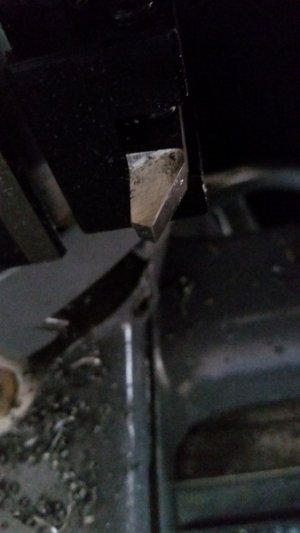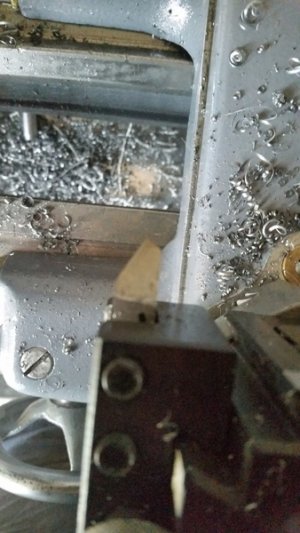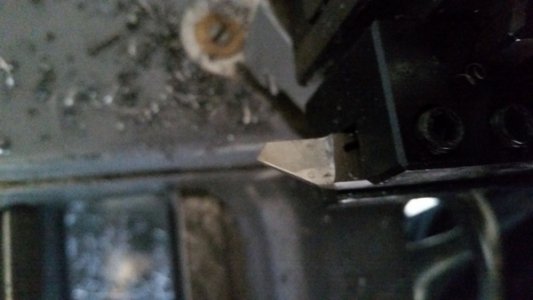-
Welcome back Guest! Did you know you can mentor other members here at H-M? If not, please check out our Relaunch of Hobby Machinist Mentoring Program!
You are using an out of date browser. It may not display this or other websites correctly.
You should upgrade or use an alternative browser.
You should upgrade or use an alternative browser.
Lathe Noob With Some Questions On First Cuts
- Thread starter Pinresto
- Start date
- Joined
- May 23, 2014
- Messages
- 100
What a great article. I had to read it twice to absorb it all. I may even read through it again after grinding and cutting some more. As I gain experience I like to re read things. The info tends to become a more clear.Helping is what this forum is about, Tony, and the Beginner's Forum in particular. Read the articles for understanding but grind the tool as I suggested above. Your lathe is far more capable than it seems right now ...
I've been grinding on my bench grinder up until today. It's difficult to get the correct angles, even with the tool rest. I guess it's because I'm grinding on a wheel and it's not a true angle. I know most people use them for grinding but I switched to my 12" disk sander. It was much easier to control. I ground what I think is a decent tool and it improved the performance. On the mystery metal I can now take a .020" doc and the hot rolled basically gives no resistance to anything I've thrown at it. It cuts like butter. I'm going to a metal supply store this weekend to pick up some stuff to play with. Do you have any recommendations? I'd like to make a set of machinist jacks for my first project. What would be a good metal to use? I'll post some pics of my new tool shortly.
Thanks again
- Joined
- Dec 20, 2012
- Messages
- 9,422
What a great article. I had to read it twice to absorb it all. I may even read through it again after grinding and cutting some more. As I gain experience I like to re read things. The info tends to become a more clear.
I've been grinding on my bench grinder up until today. It's difficult to get the correct angles, even with the tool rest. I guess it's because I'm grinding on a wheel and it's not a true angle. I know most people use them for grinding but I switched to my 12" disk sander. It was much easier to control. I ground what I think is a decent tool and it improved the performance. On the mystery metal I can now take a .020" doc and the hot rolled basically gives no resistance to anything I've thrown at it. It cuts like butter. I'm going to a metal supply store this weekend to pick up some stuff to play with. Do you have any recommendations? I'd like to make a set of machinist jacks for my first project. What would be a good metal to use? I'll post some pics of my new tool shortly.
Thanks again
Are you sure you've only ground a few tools, Tony? That looks like a fine tool to me! It sounds like it cuts better so can we assume we're past this depth of cut problem?
Now you need to learn to use that tool. Make small changes to the lead angle until you find your sweet spot for the particular operation you're doing. Roughing, facing and finishing will each have a sweet spot for every tool and you need to find yours. Once you do I think that tool will serve you well. Good job, Tony! You learn fast!
Before you go on to projects maybe it might be a good idea to learn to use your lathe first. My advice to new guys is to start with materials that are easy to cut so you learn how the lathe works and, to my mind at least, 12L14 or 6061 Aluminum are the best materials to learn on. You not only have to learn your lathe, you need to build the skills to use it well. Slow down, take your time and build your skills.
By the way, do you have a mill? How often do you think a machinist's jack is actually used in a hobby shop? Might want to think about making tools you will actually use every day, no?
- Joined
- Dec 20, 2012
- Messages
- 9,422
I forgot to mention - it looks like the side relief and side rake angles don't quite meet. There is an area of brightness at the cutting edge that indicates a dull edge. You can either grind it to correct this or hone the tool but that edge should be razor sharp.
Your chips look good - wide and thin, just like this tool should produce. The cutting angles are more acute and the increased back rake shifts the cutting load toward the tip so it should finish pretty well. A tool with standard geometry will cut with thicker and tightly curled chips in steel but this one is not standard so the chips will look different.
Your chips look good - wide and thin, just like this tool should produce. The cutting angles are more acute and the increased back rake shifts the cutting load toward the tip so it should finish pretty well. A tool with standard geometry will cut with thicker and tightly curled chips in steel but this one is not standard so the chips will look different.
- Joined
- Mar 19, 2014
- Messages
- 2,681
In your pic its looks like the business end/point is worn down or was stoned that way? In any event, that would definitely give you cutting problems. Tool bit geometry is debatable, but I think we can all agree that a tool bit needs front angle and end angle relief. Back angle, well, I have not put a back angle on a tool bit in over 40 years now. Why, because it makes it MUCH easier to re-sharpen the bit and my tool height stays the same. Do I notice a difference in cutting action, how would I know, have not needed to change, everything is good the way it is. Your using ISO68 I guess is better than nothing. Maybe try some Rigid cutting oil. That stuff should be readily found at a hardware store. And maybe try some 12L14 steel for your projects…Good Luck, Dave.
- Joined
- Sep 29, 2014
- Messages
- 2,102
Gunrunner you need to order a set of these for the Z axis hand crank. Bill did you just spit coffee on your monitor? :rofl:
View attachment 253356

View attachment 253356

- Joined
- May 23, 2014
- Messages
- 100
Are you sure you've only ground a few tools, Tony? That looks like a fine tool to me! It sounds like it cuts better so can we assume we're past this depth of cut problem?
Now you need to learn to use that tool. Make small changes to the lead angle until you find your sweet spot for the particular operation you're doing. Roughing, facing and finishing will each have a sweet spot for every tool and you need to find yours. Once you do I think that tool will serve you well. Good job, Tony! You learn fast!
Before you go on to projects maybe it might be a good idea to learn to use your lathe first. My advice to new guys is to start with materials that are easy to cut so you learn how the lathe works and, to my mind at least, 12L14 or 6061 Aluminum are the best materials to learn on. You not only have to learn your lathe, you need to build the skills to use it well. Slow down, take your time and build your skills.
By the way, do you have a mill? How often do you think a machinist's jack is actually used in a hobby shop? Might want to think about making tools you will actually use every day, no?
I have an x2 mini mill I use fairly often. I figured machinist jacks would be fairly easy to make and a good way to learn. I'm not quite ready to make them. I need to actually cut a thread first,lol.
Do you think here in panama they use the same numbering system for their metals? Do they call 12l14 , 12l14? Might be a dumb question as I'm sure they do. Is it a world wide standard?
That shines edge on my tool came from honing it. It felt fairly sharp but not perfect so I've still got some improvemets to make.
Any suggestions on useful beginners tools?
- Joined
- May 23, 2014
- Messages
- 100
In your pic its looks like the business end/point is worn down or was stoned that way? In any event, that would definitely give you cutting problems. Tool bit geometry is debatable, but I think we can all agree that a tool bit needs front angle and end angle relief. Back angle, well, I have not put a back angle on a tool bit in over 40 years now. Why, because it makes it MUCH easier to re-sharpen the bit and my tool height stays the same. Do I notice a difference in cutting action, how would I know, have not needed to change, everything is good the way it is. Your using ISO68 I guess is better than nothing. Maybe try some Rigid cutting oil. That stuff should be readily found at a hardware store. And maybe try some 12L14 steel for your projects…Good Luck, Dave.
Is the ridgid cutting oil the same stuff they use for threading pipe?




